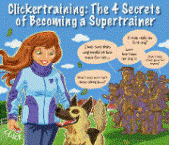Good Dog Training Advice
Get Fast & Simple Dog Training Tips to
Turn a Difficult Dog Into an Obedient Pet!
Use Of Dog Obedience Hand Signals
Training a dog takes time and patience, but with consistency and positive reinforcement you will find that in no time your pet will be a loyal obedient friend for life. Communication with your pet has always been thought of as speaking to the dog and him doing what you say, but this is not true. A dog will associate body language and tone of voice to words then respond to those two actions. So when you are working with your dog, the use of dog obedience hand signals will increase his learning capability quicker than conventional training methods. Why Use Hand Signals When Dog Training Teaching your dog to respond to hand signals are beneficial for many reasons. With strong training you will be able to control your dog’s behavior at a distance even if your dog is out of voice range and he can only see your hand. Most dogs respond to what they see not what they hear, so it is important that our body movements reflect what is wanted from our pet. By using hand signals just before giving a verbal command you are teaching the dog that your movement is consistent with the command that is following it. The Different Uses of Hand Signals When Working With Your Pet Hand signals are best used with the six basic obedient commands; Come, stay, heel, sit, stay, and down. Each command has a specific hand signal that indicates what the dog is to do. It is possible to make up your own hand signals, just remember to be consistent and not to change them once they are introduced. An example of the different signals can be shown in the command “down”. One signal is to face the dog with your hand up so you have his attention, than lower your hand down in front of him. The other way is with your arm straight to your side; open your hand with your palm facing down at the ground. Training Hand Signals To Your Dog As in any training you will need to work with your dog for a period of time before he completely understands what you are asking of him. Using verbal commands are good when working with hand signals, but there needs to be some distinction between the two for the training to be effective. If you are going to use verbal commands then say the word after the hand signal so that the dog can associate the body movement with the command. The other way around confuses the animal and the signal has no meaning. Do not praise or give a treat until the command has been completed. If you are using both hand and verbal commands rewards should not come before completing the action. The use of dog obedience hand signals is important in any dog’s training program. A dog that is well trained will be worth every effort that is put into him. One benefit is when your pet gets older and his hearing starts to wane he will know exactly what you want from him.
| |
|


Discover the Secrets to Training Your Dog Or Puppy. Huge BONUSES for a limited time only!
Click here now...
|
http://GoodDogTrainingAdvice.com






